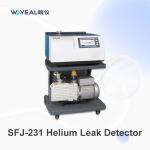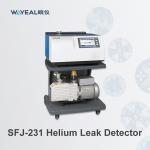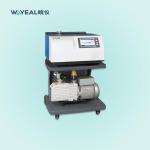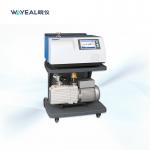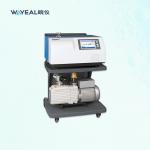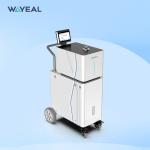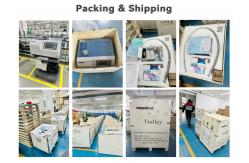Technical Specifications of Helium Leak Detector SFJ-231
| Product Name | Helium Leak Detector SFJ-231 |
| Diamension | 645*678*965mm |
| Operating temperature | 0~40°C |
| Detectable Quality | 2, 3, 4 (H2, He3, He4) |
| User Interface | 7inch Color Touch Screen |
| Detection Method | Helium Leak Detection |
| Mini Leak Detection Rate(Pa.m3/s)/Vaccum Mode | 5*10-13 Pa·m3/s |
| Communication Interface | RS232/485, USB*2 |
| Max Allowable Leak Detection Pressure (Pa) | 1500 |
| Ion Source | 2pcs, Iridium Coated Yttrium Oxide, Automatic Switching |
| Main Features | Mass Spectrometer Leak Detector, Helium mass spectrometer Leak
Detector, helium leak testing |
| Mini Leak Detection Rate(Pa.m3/s)/Sniffer Mode | 5*10-9 Pa·m3/s |
| Start Time | 2min |
| Leak Detection Port | DN25KF |
| Power | AC220V, 50Hz/60Hz |
| Language | Chinese/English |
Helium Leak Detection in Automotive Fuel System
Helium mass spectrometer leak detectors are widely used in
automotive fuel system leak detection due to their high sensitivity
(up to 10⁻⁹ Pa·m³/s) and reliability. They are commonly used for
leak detection in components such as fuel tanks, fuel lines, and
evaporative emission systems.The following provides a detailed explanation of specific
applications, leak detection methods, and procedures:
1. Vacuum Method (Negative Pressure Leak Detection)
Application Scenarios: Overall leak detection of sealed components such as fuel tanks and
sealed pipelines.
Detection Steps:
- Vacuuming: Evacuate the fuel system to 10⁻² to 10⁻³ Pa (requires a vacuum
pump system).
- Helium Blowing: Spray helium gas (pressure 0.1 to 0.2 MPa) around the test area
(e.g., welds, joints).
- Detection Signal: Helium entering the system through leaks is captured by a mass
spectrometer and triggers an alarm.
- Leak Point Localization: The leak point location is determined by moving the spray gun or
segmentally isolating the system.
2. Pressurization Method (Positive Pressure Leak Detection)
Applicable scenarios: EVAP carbon canisters, fuel lines, and other pressure-resistant
components.
Detection Steps:
- Helium mixture injection: Inject a mixture of 5%–10% helium and nitrogen into the component
(pressure 0.3–0.5MPa).
- Seal and maintain pressure: After stabilizing the pressure, place the component in a vacuum
chamber or connect it to the leak detector's suction gun.
- Detect leaks: Use a mass spectrometer to detect helium escaping from the leak.
- Advantages: Suitable for complex-shaped components, no need for overall vacuum
extraction.
3. Sniffer Method (Local Scanning)
Application Scenarios: Online rapid leak detection of fuel systems that have been
assembled (e.g., engine compartment piping).
Detection Steps:
- Internal Helium Filling: Fill the fuel system with helium (working pressure).
- External Scanning: Move the suction gun along weld seams, O-rings, and other areas
(distance 1–3 mm).
- Real-Time Feedback: The mass spectrometer peak corresponds to the leak location
